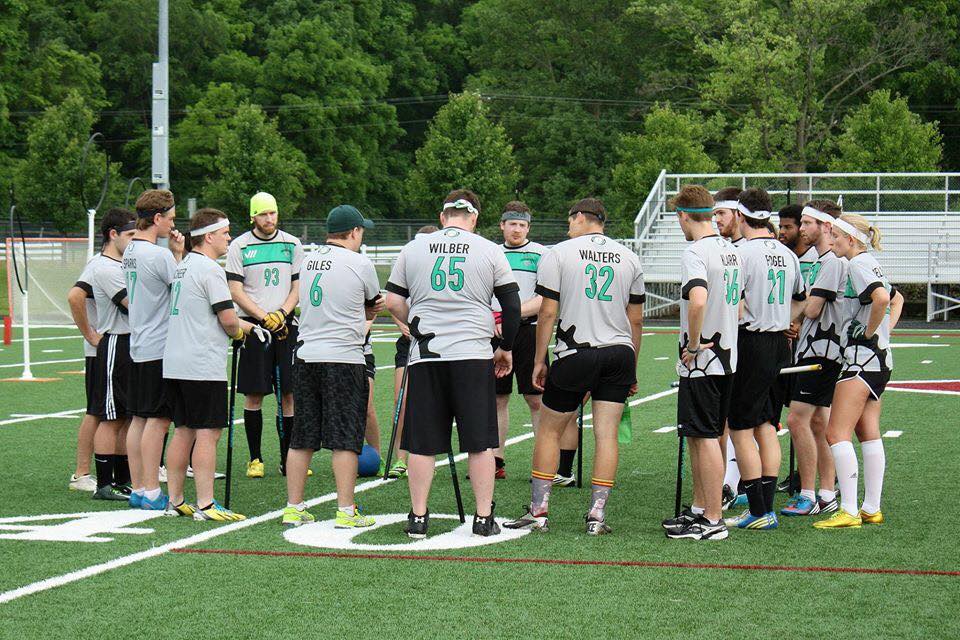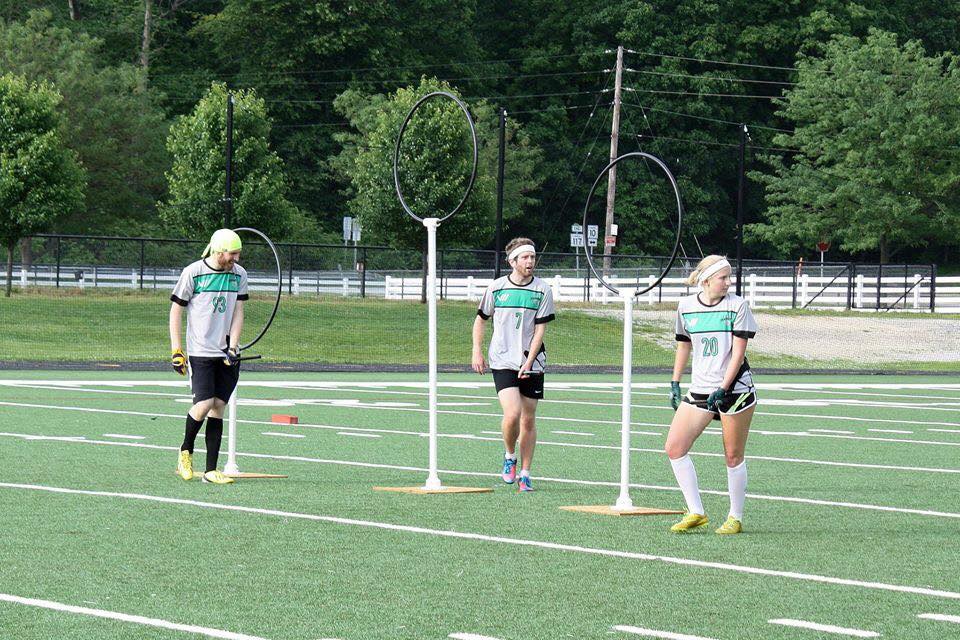Antwerp QC, Much of Belgian Core, Leaves Competitive Quidditch
The general consensus around the quidditch community coming into MLQ’s first series was that the Indianapolis Intensity had a chemistry advantage, but the Detroit Innovators’ edges in both raw athleticism and talent would prove too much to handle. Indianapolis would probably pull off a single win, but as Detroit got better throughout the day, the Innovators would pull away in each and every match.
It only took one weekend for MLQ to grant us our first mini-upset, and in an emphatic fashion. The Indianapolis Intensity swept the three-game series in Culver, Indiana, leading in quaffle points in every contest and taking the second out of snitch range. Indianapolis rarely trailed at any point, save for a short stretch in the beginning of the third match. Detroit was not able to use its size advantage effectively and, shockingly, fell on the wrong side of multiple no-bludger situations. How exactly did we get to this point?
Match One: Indianapolis 110*, Detroit 60
The first match of MLQ was not exactly the prettiest quidditch to watch. Both teams were clearly shaking off some rust after two months away from competitive match play and struggled to develop consistent offensive attacks. When Detroit had at least a bludger back on defense, Intensity only scored on 4 out of 17 attempts (23.5 percent). The Innovators similarly struggled on offense, putting goals home on 5 out of 22 attempts (22.7 percent) in the same situation. So why did Indianapolis win this game?
Looking at the beater stats provides a shocking answer: Intensity held bludger control for over 83% of the game. It doesn’t really matter how effective any team’s offense is; going up against two bludgers four out of every five tries will not yield good results. This edge included almost the entirety of the time the snitch was on the pitch, keeping Detroit’s seekers completely away to give Jason Bowling free runs at an easy grab. For a beating line that includes Ashley Calhoun, Jim Richert, Tad Walters and Ryan Sparks, 17 percent of bludger control is completely unacceptable.
Detroit’s lack of chemistry on offense, coupled with a severe lack of bludger control, created the final straw that broke the Innovators’ back: five zero-bludger drives late in the match. Detroit’s chasers were not aware of their beaters’ progress in regaining control on offense and took ill-timed drives and long passes while their beaters were scrambling to get one bludger back. The ensuing turnovers led to four easy goals for Indianapolis, turning an otherwise even match into a near-blowout. It took two spectacular long-range shots from Alex Scheer late in the match for the Innovators to get back into range, but Bowling would seal the victory for Indianapolis before Detroit could get any true runs at the snitch.
Match Two: Indianapolis 150*, Detroit 60
This out-of-range victory for Indianapolis was much closer than the score indicated early on. Indianapolis still won the bludger battle, but Detroit stemmed the bleeding to a manageable 65 percent as opposed to 83 percent in the first match. The quaffle play in general took a step forward in this game, with both teams making solid tackles on defense and scoring via a few extra passes compared to the prior match. In fact, the game was still in snitch range at the 18-minute mark, and Detroit seemed to have more momentum on its side and stronger physical play.
Unfortunately for Detroit, the match never should have been in range at the 18-minute mark or, at the very least, the Innovators should have held the lead. At 7:30 minutes in the match, Indianapolis beater Alex Didat picks up his second yellow card in less than 2 minutes, giving Detroit a huge opportunity to rack up some goals. Detroit scored on its first possession against a lone beater (for some reason not bringing either of their beaters to help) and forced an Indianapolis turnover relatively quickly.
The major failure comes on this possession—instead of immediately taking all six players on a fast break, Detroit inexplicably takes 20 seconds to sub out two chasers and both beaters while keeper Matt Oates literally walks up the field. Dylan Schepers scores quickly enough—by throwing the quaffle hard through the front of the hoops, wasting another 25 seconds before Indianapolis brings the ball up again. Detroit then keeps its beaters, under zero pressure, at its own keeper zone line, letting Indianapolis have 15 seconds of free time to pass around. Erin Moreno makes a great goal-saving beat after the turnover, and Walker comes back in a few seconds later. Detroit only scores twice in the 2 minutes it played a beater up, and neither of its bludgers crosses midfield. Over a minute of the most valuable time of the match was wasted by poor decision-making, which, if used effectively, could have pushed Detroit into the lead and in control of the match.
Instead, the match is nearly tied when the snitch comes on the field. Ten minutes later Indianapolis would be six goals ahead while Detroit dejectedly walked up the pitch. Coach Tyler Walker’s regain of bludger control while snitch beating proved to be crucial. Once Walker got control, he would help Indianapolis maintain it for 17 out of the last 20 possessions of the match. Yet again, Detroit found itself unable to make any real runs at the snitch.
Indianapolis made an interesting choice when it regained control: Walker left the snitch and joined the rest of his team on defense, leaving Bowling to go after the snitch alone. Detroit took the opportunity to send a lone bludger at the snitch to try to sneak away with a win—a strategy that aided in its undoing. Detroit’s chasing game was impatient, driving into the defense precisely when its beaters were helping out the seeker. On four straight offensive possessions, Detroit turned over the quaffle to Indianapolis, granting four goals on no-bludger drives. A one goal lead swelled to five in the course of about 3 minutes before Detroit finally pulled its beaters away from the snitch to try to regain control. Simultaneously a coaching and chemistry-induced error, this 3-minute stretch completely sealed the victory for Indianapolis.
Match Three: Indianapolis 150*, Detroit 90
Having already lost the series, Detroit came out in the third match running a Baylor University-esque hoop zone defense. Was it a desperation tactic? Probably, but this would prove to be the best match Detroit played. Finally winning the bludger control battle at 56 percent, Detroit was able to use its size very effectively in this match on offense, but Indianapolis countered with a seasoned passing attack that proved very effective at overstretching a team inexperienced in a hoop zone.
Early in the match we finally saw Detroit’s best beating pair, Calhoun and Tad Walters, hit their stride and take control of the match. Holding onto bludger control for all but one possession they shared together, Indianapolis was not able to begin most possessions with anything better than a spooked pass high over the hoops. Walters created two goals with seasoned 1.5 runs on offense, clearing out Indianapolis’ beaters with ease. Detroit clearly had the momentum and, for once, the lead.
Unfortunately, even the best players have to sub out eventually. Richert played well in Walters’ stead, but slowly the Indianapolis beating corps wrestled control back to its half of the pitch. With Calhoun off the field, Detroit’s zone crumbled, letting Indianapolis have way too much time on offense to pass around the edge of the zone before driving in for easy dunks. Once the snitch came on the pitch, bludger control became largely irrelevant, with neither team able to hold on for very long. Both teams took advantage of multiple no-bludger drives for easy goals, but Indianapolis had done too much damage to Detroit’s zone early in the match. Detroit was barely able to hold the contest within three goals, and Blake Fitzgerald would end up pulling the final snitch, cementing a fantastic start for Intensity’s MLQ season.
Final Grades and Parting Shots
DETROIT INNOVATORS: D+ If there is a silver lining, I honestly cannot imagine a roster this talented playing much worse over three matches. The beating game, especially, should continue to improve in the same manner we saw this past weekend. The team’s lack of a seeker is still a massive hole in the roster that will need to be addressed for the rest of the season. However, the third match finally granted some fleeting impressions of a physical team that dominates when it has bludger control. Detroit will not go winless this season but needs to have two great series against Cleveland Riff and Rochester Whiteout if it wants to climb out of the basement of the North Division.
INDIANAPOLIS INTENSITY: B+ Indianapolis has a great start to build on going forward. The rust is gone, and the team’s chemistry from its plethora of Ball State University players is obviously intact. However, this was not anything close to a dominating performance. Two matches were essentially gifted via poor beater play, coaching and chemistry. The Intensity did close out matches exceedingly well; three snitch catches is an especially strong showing that should not be overlooked going forward. I do not expect Indianapolis to run the table for 9-0, but the team has an incredible amount of momentum going into its match against Cleveland this weekend.
PARTING SHOT Detroit needs to go back to the drawing board and practice more than it did coming into this match. This team cannot afford another series like this. This upcoming weekend’s showdown between Indianapolis and Riff will tell us whether this advantage in chemistry is a legitimate factor in MLQ or a single-weekend anomaly. It will be interesting to see if Intensity tries to change up any strategies for Riff, or if it will stand pat and stick with what worked here.
Finally, astute fans know that Indianapolis is not the only chemistry-driven team in the North Division. Rochester, on paper, has arguably more talent than the Innovators, while also having a similar chemistry advantage. Seventeen of 25 players for the Whiteout hail from either the University of Rochester or RIT, two teams that know each other as well as they know themselves. If chemistry does prove to be a defining trait of the MLQ season, Whiteout may find itself as the clear favorite in the North Division.
Archives by Month:
- May 2023
- April 2023
- April 2022
- January 2021
- October 2020
- September 2020
- July 2020
- May 2020
- April 2020
- March 2020
- February 2020
- January 2020
- December 2019
- November 2019
- October 2019
- August 2019
- April 2019
- March 2019
- February 2019
- January 2019
- November 2018
- October 2018
- September 2018
- August 2018
- July 2018
- June 2018
- April 2018
- March 2018
- February 2018
- January 2018
- November 2017
- October 2017
- July 2017
- June 2017
- May 2017
- April 2017
- March 2017
- February 2017
- January 2017
- December 2016
- November 2016
- October 2016
- September 2016
- August 2016
- July 2016
- June 2016
- May 2016
- April 2016
- March 2016
- February 2016
- January 2016
- December 2015
- November 2015
- October 2015
- September 2015
- August 2015
- July 2015
- June 2015
- May 2015
- April 2015
- March 2015
- February 2015
- January 2015
- December 2014
- November 2014
- October 2014
- September 2014
- August 2014
- July 2014
- May 2014
- April 2014
- March 2014
- February 2014
- January 2014
- November 2013
- October 2013
- September 2013
- August 2013
- July 2013
- June 2013
- May 2013
- April 2013
- March 2013
- February 2013
- January 2013
- December 2012
- November 2012
- October 2012
Archives by Subject:
- Categories
- Awards
- College/Community Split
- Column
- Community Teams
- Countdown to Columbia
- DIY
- Drills
- Elo Rankings
- Fantasy Fantasy Tournaments
- Game & Tournament Reports
- General
- History Of
- International
- IQA World Cup
- Major League Quidditch
- March Madness
- Matches of the Decade
- Monday Water Cooler
- News
- Positional Strategy
- Press Release
- Profiles
- Quidditch Australia
- Rankings Wrap-Up
- Referees
- Rock Hill Roll Call
- Rules and Policy
- Statistic
- Strategy
- Team Management
- Team USA
- The Pitch
- The Quidditch Lens
- Top 10 College
- Top 10 Community
- Top 20
- Uncategorized
- US Quarantine Cup
- US Quidditch Cup



